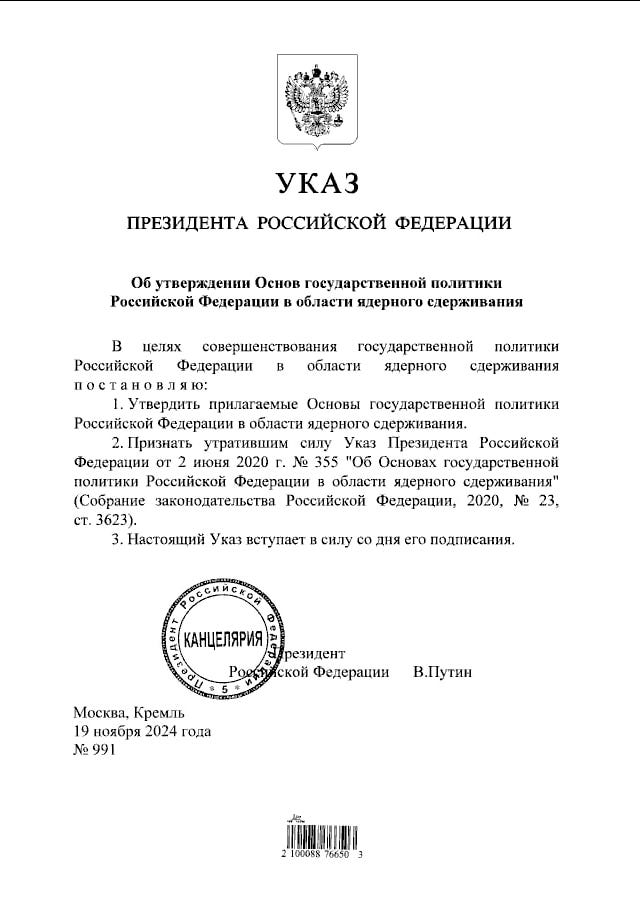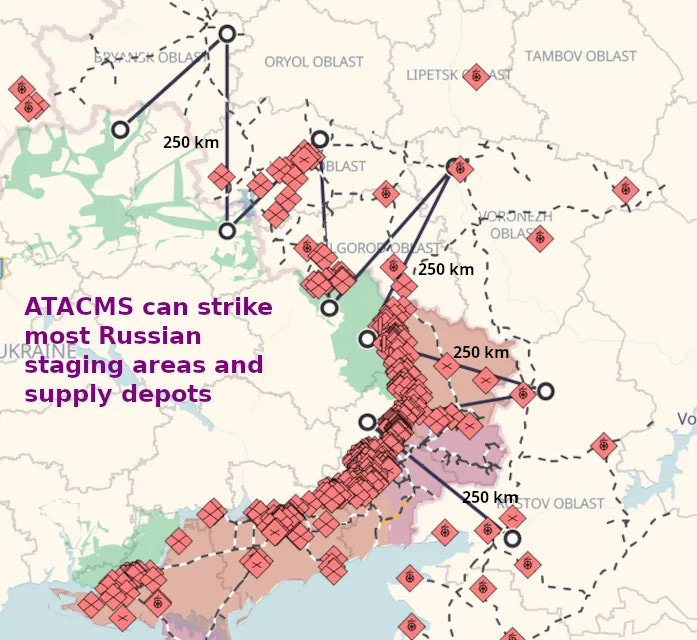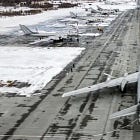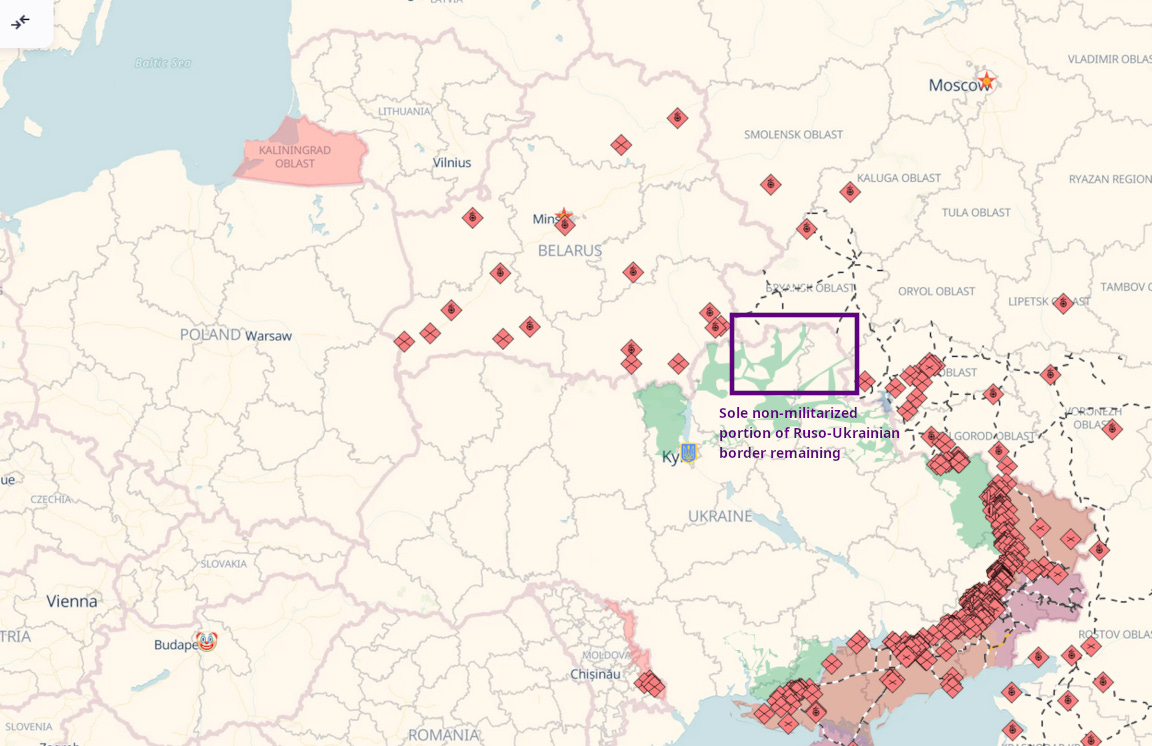Has World War 3 begun?
Certainly there are those who believe Ukraine’s use of the United States’ Army Tactical Missile System (ATACMS) to attack a weapons depot in the Bryansk Oblast of Russia could be the opening salvo of a widening Ukrainian conflict.
On the night of November 19, 2024, units of the Armed Forces of Ukraine, in cooperation with other components of the Defense Forces, inflicted fire damage to the arsenal of 1046 of the logistics center near the city of Karachev, Bryansk region of the russian federation.
As of 02.30 a.m., 12 secondary explosions and a detonation in the area of the target were recorded.
The defeat of ammunition depots for the army of the Russian occupiers will continue to stop the armed aggression of the russian federation against Ukraine.
Next will be...
Glory to Ukraine!
This comes almost immediately on the heels of Joe Biden authorizing such long range strikes into Russia using the ATACMS munitions—one does not have to be any sort of military genius to surmise Ukraine has been waiting for the US to greenlight such attacks.
Is this an escalation of US involvement in Ukraine? To a degree, yes. US made weapons are being used to attack Russia directly—an offensive rather than defensive role.
How much more than that is it? Arguably, not a lot more.
I want to reiterate my overall stance on the war in Ukraine: I want it to end, and end quickly. I want there to be a lasting peace between Ukraine and Russia. I want the killing and the dying to stop.
As for what will constitute a “lasting peace” between Russia and Ukraine, that is a question they will have to sort for themselves. Other than facilitating negotiations, other countries should not involve themselves in deciding Ukraine’s future.
Biden’s authorizing Ukraine to attack targets on Russian soil using ATACMS certainly does not look like the sort of decision that is likely to bring about peace sooner rather than later. Indeed, the corporate media is presenting Biden’s decision as a deliberate tit-for-tat escalation following reports of North Korean forces joining Russia’s invasion force.
The decision allowing Ukraine to use the Army Tactical Missile System, or ATACMs, for attacks farther into Russia comes as thousands of North Korean troops have been sent into a region along Ukraine’s northern border to help Russia retake ground and as President-elect Donald Trump has said he would bring about a swift end to the war, expressing skepticism over continued support by the United States.
However, we should realize that extending a grinding war of attrition in Ukraine has always been the centerpiece of NATO’s strategy for that war. Secretary of Defense Lloyd Austin said as much very early on during a visit to Kyiv.
That message was delivered most clearly on Monday, when Secretary of Defense Lloyd Austin told reporters after a trip to Ukraine’s capital city of Kyiv that “we want to see Russia weakened to the degree that it can’t do the kinds of things that it has done in invading Ukraine.”
While the rhetoric has been couched in terms of Ukraine “winning” the war, the actions have been far more problematic. We should remember that in the fall of 2022, the US military leadership claimed Ukraine did not even need the ATACMS munitions.
"It's our assessment that they don't currently require ATACMS to service targets that are directly relevant to the current fight," Under Secretary of Defense for Policy Colin Kahl told reporters in late-August.
Last week, Defense Secretary Lloyd Austin intimated the US position hasn't shifted. "The HIMARS, using the GMLRS rockets, have been extraordinary in terms of enabling the Ukrainians to service the targets that they need to service inside of Ukraine," Austin said in Prague on Friday, making no mention of ATACMS.
Note Colin Kahl’s choice of words: “current fight.”
The Pentagon was, apparently, mostly interested in addressing the immediate tactical needs of the Ukrainian military—exactly the approach one would take to prolong a war of attrition with Russia, which Lloyd Austin had already confirmed was what NATO wanted in Ukraine.
Not until the fall of 2023 did Joe Biden and his handlers approve ATACMS deliveries to Ukraine.
Biden made the pledge to Zelenskyy during the Ukrainian leader’s visit to the White House on Thursday, fulfilling a long-held wish by Kyiv, according to the officials who like others for this story were granted anonymity to speak about private conversations.
The Army Tactical Missile Systems will likely be delivered to Ukraine in the coming weeks. The White House declined to comment on the matter
Now, one year after that, Biden greenlights Ukraine using the ATACMS munitions to attack targets inside Russia.
While this escalation might conveniently use the excuse of North Korean soldiers aiding Russia on the battlefield as an excuse, the incrementalism that has been on display in US aid to Ukraine from the beginning suggests that Biden’s authorization was inevitable. Any excuse would have served; North Korea’s sending forces to fight alongside Russia was merely the convenient excuse du jour.
Remember, a Ukrainian victory has only been a superficial objective to the military thinkers in the Pentagon. For them, the larger and more meaningful objective has always been to “attrit” Russia’s miiltary, and effectively end it as a fighting force.
Russia has been badly bloodied. Of its prewar army, perhaps a quarter of its troops were killed or wounded in its initial attacks on Ukraine. A hastily mobilized force of men swept up in a press-ganging effort is also suffering casualties at a horrific rate. But the losses have not yet broken the Russian army or the determination of the Putin regime in Moscow. Indeed, Ukrainian sources report that a new mobilization is being prepared with the aim of more than doubling the size of the Russian military to a total force of as many as 2 million personnel.
From the very beginning, NATO’s strategy for Ukraine can be summarized thus: NATO provides the cannons, and Ukraine provides the cannon fodder. So long as Ukraine is killing Russian soldiers, NATO is seeing its stated objectives met.
An actual victory for Ukraine has never been a priority for NATO.
If Biden is engaged in a tit-for-tat escalation with Russia (and he is), does that mean that Russia is going to do something of its own to take the war’s intensity up a notch?
Theoretically, yes. That has been the tempo of the war all along. Whenever Ukraine has made a notable move to change the dynamic of the war, Russia has responded, often with massive missile barrages targeting Ukraine’s civilian population.
As evidence by the fact that the war is ongoing, neither Putin’s escalations nor his bellicose rhetoric have had the presumptively desired effect of dissuading NATO from supporting Ukraine further.
Thus Putin from time to time rattles his nuclear saber which he has just done by revising Russia’ nuclear doctrine.
A number of observers view Putin’s signing of the revised doctrine to be in response to Ukraine’s inaugural use of ATACMS.
That confirmation of a lowering of Russia's threshold for the use of nuclear weapons emerged on the same day Moscow says Ukraine has fired US ballistic missiles against Russian territory for the first time is surely no coincidence.
This comes on top of Putin’s rhetoric from September 12 where he stated that Ukrainian use of long-range munitions would mean that NATO was actually at war with Russia.
Russian state media has promoted President Vladimir Putin’s remarks on the possibility of British and American-supplied weapons striking deep into Russia, presumably to take out airbases where strikes against Ukraine are launched, presently well out of Kyiv’s reach. The President of the Russian Federation said such strikes would “change the very nature of the conflict” and would “mean that NATO countries, the U.S., European countries, are at war with Russia.”
Putin’s spokesman followed up on Friday, asserting that the message was “extremely clear, unambiguous and admits of no dual interpretations”, and had been “no doubt” received by its intended audience, the leadership of NATO states.
Quite conceivably, Putin’s revising the nuclear doctrine is a preparatory step towards making good on that threat.
Kremlin spokesman Dimitry Peskov took to Telegram in the wake of the Ukraine attack on Bryansk to repeat Putin’s September warning.
Peskov – about the timing of the end of the SVO: When it all began, it began against the Kiev regime. And now it continues as a war between Russia and NATO. That’s why it took a little more time and will last a little longer. I don’t think it’s possible to answer the question when the SVO can end when it might come to an end. But the only thing I can tell you is will end as soon as we achieve our goals.
At a minimum, then we must consider the possibility that Putin is not bluffing by revising Russia’s nuclear doctrine to allow for a nuclear response to a non-nuclear attack.
Yet how much of an escalation is the use of ATACMS?
At the theater level, it could be a significant shift in battlefield dynamics. The use of ATACMS, which has a range of up to 300 kilometers, has the potential to bring most of Russia’s rear staging areas under direct missile attack1.
If ATACMS were used on the eastern front in Ukraine, Russia’s main supply hubs around Rostov-On-Don potentially come under attack.
This would not be a complete “game changer”, but it could force Russia to reposition supply depots and staging areas farther back from the front lines, and that added distance would pose a complication for Russia’s logistics efforts. At a minimum it would slow down the pace of Russia reinforcement of the front line. It could also compel Russia to redeploy air assets farther back.
These would not by themselves lead to a collapse of the Russian front lines, but the added stresses could prove impactful in slowing or stopping Russian advances in the east.
Remember, keeping the attrition going is what NATO wants. Biden giving Ukraine authorization to attack targets inside Russia with ATACMS at this juncture appears to be the sort of calibrated and “managed” escalation intended to do just that.
Beyond the battlefield, however, as an escalation it does not change very much. Ukraine has mounted successful drone attacks deep inside Russia, and has even targeted portions of Russia’s nuclear deterrent force as early as the winter of 2022.
Indeed, Ukraine’s success with its drone attacks has since 2022 been a constant reminder that Russia’s strategic infrastructure is exposed and vulnerable in several regards—not the least of which is Russia’s all-important energy infrastructure.
Perhaps more crucially, however, is the sobering reality that Putin’s options for escalation are increasingly limited. As it stands, one consequence of Ukraine’s invasion of Kursk is that very little of Ukraine’s border with Russia is not already highly militarized.
The rest of the border is fundamentally one long battlefield.
Putin has already done massive missile strikes across the whole of Ukraine. As an escalation that is not going to go very far.
Indeed, Putin’s lack of escalation options may be one reason why the financial markets largely shrugged off news of the ATACMS strike.
Despite opening down significantly, all the major indices quickly recovered, with only the Dow posting a loss on the day.
Does this mean that Putin is powerless to do anything to respond to Ukraine’s newfound long-range capacity?
There’s always the nuclear option. That is not a threat to be taken lightly. Indeed, no less a military mind than Lieutenant General (Ret) Mike Flynn takes it so seriously he feels that Biden should be impeached for having authorized the ATACMS use against Russian territory.
First, Vice President Harris and the Biden Cabinet must invoke the 25th Amendment, and remove Biden as President. Biden is sleep-walking us into a hot war with Russia without a Congressional Declaration of War. If he lives past January 20, Biden will take the position he took with Special Counsel Hur who nine months ago declared Biden could not be held responsible for crimes, as he was on old man with a poor memory. It’s past time to put Kamala in the Oval Office — then we will know the name of the person in charge — someone who was actually elected to office. And she would be a person who could be held accountable for what disaster might befall the nation. Bearing that type of responsibility might force Harris to act responsibly. No longer would decisions be made by Unknown and Unidentified Deep State Operatives who would scatter like roaches should a crisis occur.
Second, at the same time as we hope the Democrats will act, the duty also falls on the current House of Representatives to impeach Biden now for endangering the nation by taking steps that constitute acts of war without a Declaration of War — a power the Constitution gives only to Congress. The indictment should then go immediately to the Senate for trial and removal. President Trump was impeached after he (supposedly) lost the 2020 election. What’s good for the goose.
Third, incoming officials in the Trump Administration need to make contact with President Putin and his staff to de-escalate the situation as best as can be done. This is exactly what I was trying to do in my conversation with Russian Ambassador Sergey Kislyak in January 2017. The same Deep State which intercepted my call and leaked it to the Press will do so again, because the Deep State is on the ropes and are desperate. No man who fears going to prison has the moral authority to lead America at this perilous time.
To be sure, the potential for a nuclear response from Putin is a significant threat.
However, that threat has been on the table since Putin invaded Ukraine.
Moreover, since the war began, in addition to considerable propaganda about the importance of defending Ukraine, the media has been replete with reports and rumors of significant Russian troop formations. During the summer of 2023, there was considerable reporting of 100,000 troops massed near Kharkiv for an imminent offensive…which never materialized.
While reliable estimates of Russia’s actual casualties are all but impossible, it seems all but certain that Russia has seen the destruction of a considerable amount of manpower and material—a level of destruction that likely was the catalyst for Putin seeking North Korean forces to join the invasion force in Ukraine.
Addtionally, there’s a problem for Putin in actually using the nuclear threat: where would he strike?
There are no good targets in Ukraine, except possibly Kyiv itself. Every other target Putin might consider lies within NATO—and a nuclear attack on NATO is sure to bring on a nuclear reprisal.
This is not to say that Putin would not order a nuclear strike somewhere in Europe. However, there are no plausible targets that do not end in a worse outcome for Russia.
Indeed, Putin’s dilemma is that there are few options to the current stalemate in eastern Ukraine that do not end in a worse outcome for Russia.
Even if Ukraine were to agree to peace terms with Russia today, with Russia keeping the territories it already has, the end result is that its border with Ukraine will have expanded by several hundred kilometers—several hundred kilometers of border which Russia will very likely have to fortify and defend, as Ukraine at some point might want those territories back. Putin would be looking at maintaining a sizable force in eastern Ukraine for the foreseeable future just to dissuade Ukraine from attempting to retake its lost territories a couple years from now.
If Putin were to return the captured territory, how he would navigate the public backlash that would almost certainly erupt, given the number of Russian dead and wounded in the war.
Then there is the challenge of returning the economy back to a peacetime state. Russia struggled to get its economy onto a wartime footing. Russia will struggle to return its economy to peacetime production. There would be no “peace dividend” for Russia, but there will very likely be a surge of inflation and some very uncertain times for the Russian ruble. That would not bode well for Putin, especially coming on the heels of an undeniably ruinous war.
Perversely, Putin and Russia are in a position right now where the current stalemate is the best outcome for the Kremlin.
The war in Ukraine is propping of the Russian economy. The war provides at least an identifiable reason for keeping recruiting levels high and expanding the army. The war is keeping NATO and the EU off balance, with the EU locked in a war of economic attrition even as Ukraine is locked with Russia in a war of military attrition. Peace would give the EU a chance to recover economically and NATO a chance to re-arm militarily.
None of the players can sustain this war indefinitely. Russia can’t, Ukraine can’t, the EU/NATO can’t.
Eventually one of them is going to falter, with Russia or the EU/NATO gaining the upper hand. Every one of the players is gambling they are not going to be the one to falter first.
Until one of them does falter, the choice that is being made is to keep playing the game as is. The status quo of attritional warfare is where Russia, Ukraine, and the EU/NATO are choosing to be.
The good news is that means World War Three is not right around the corner.
The bad news is that the war in Ukraine will continue for some time yet. God help the Ukrainian people who have to try to live through it.
The battlefield maps are courtesy of DeepState MAP. While they are partisan as regards their description of deployments and troop movements, they have been reasonably accurate as to what forces are positioned where.












Trump has created the great expectation that he will very quickly be able to bring an end to the war. It appears that, in light of this expectation, Putin is trying to bide his time without taking radical action. Let’s hope that Trump can fulfill the expectation of peace he has created. Despite the MSM’s “black hole” on the casualty count, hundreds of thousands of our human brethren have been slaughtered there, and that slaughter is still happening at this moment.
Thanks for this analysis.